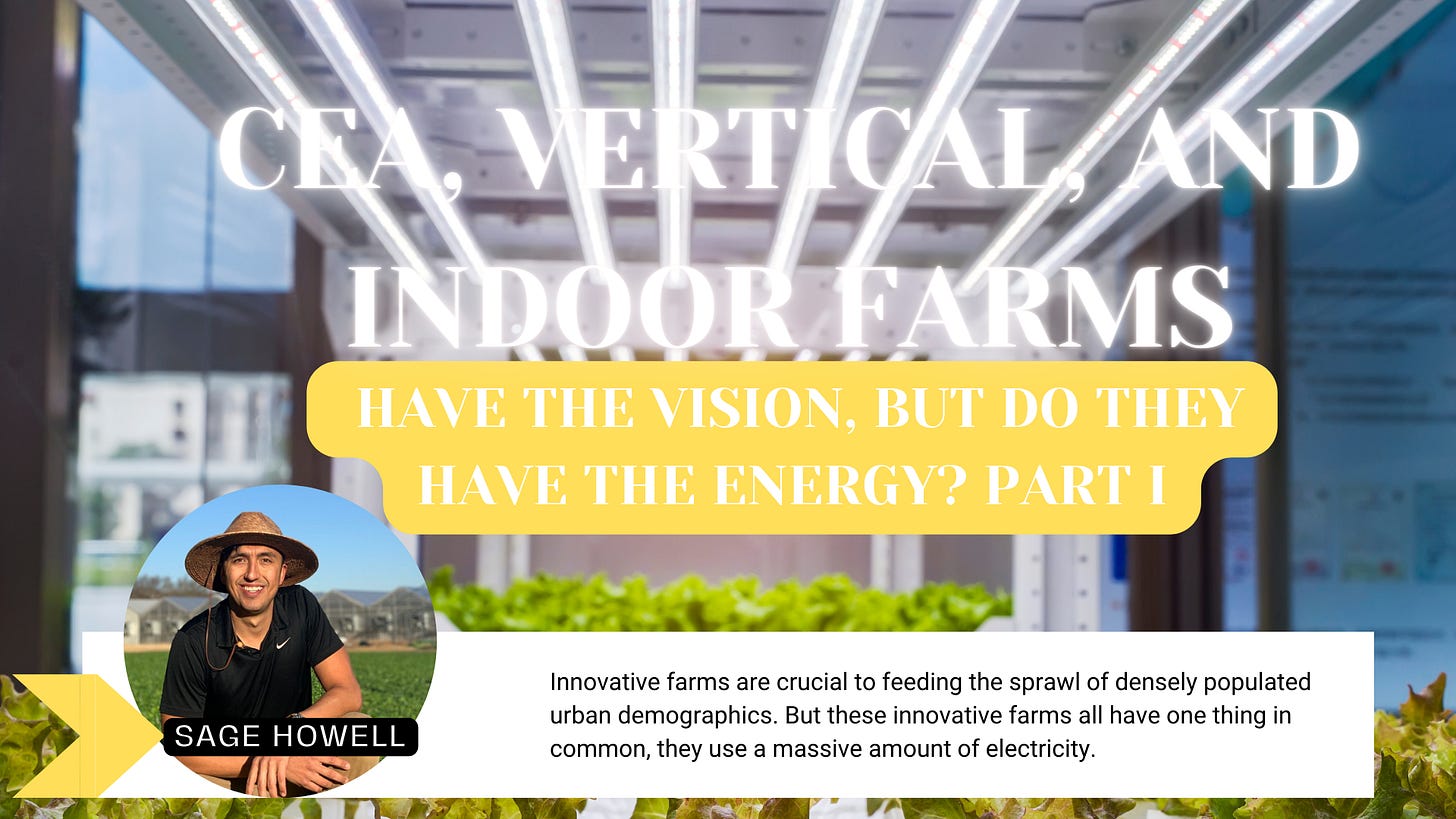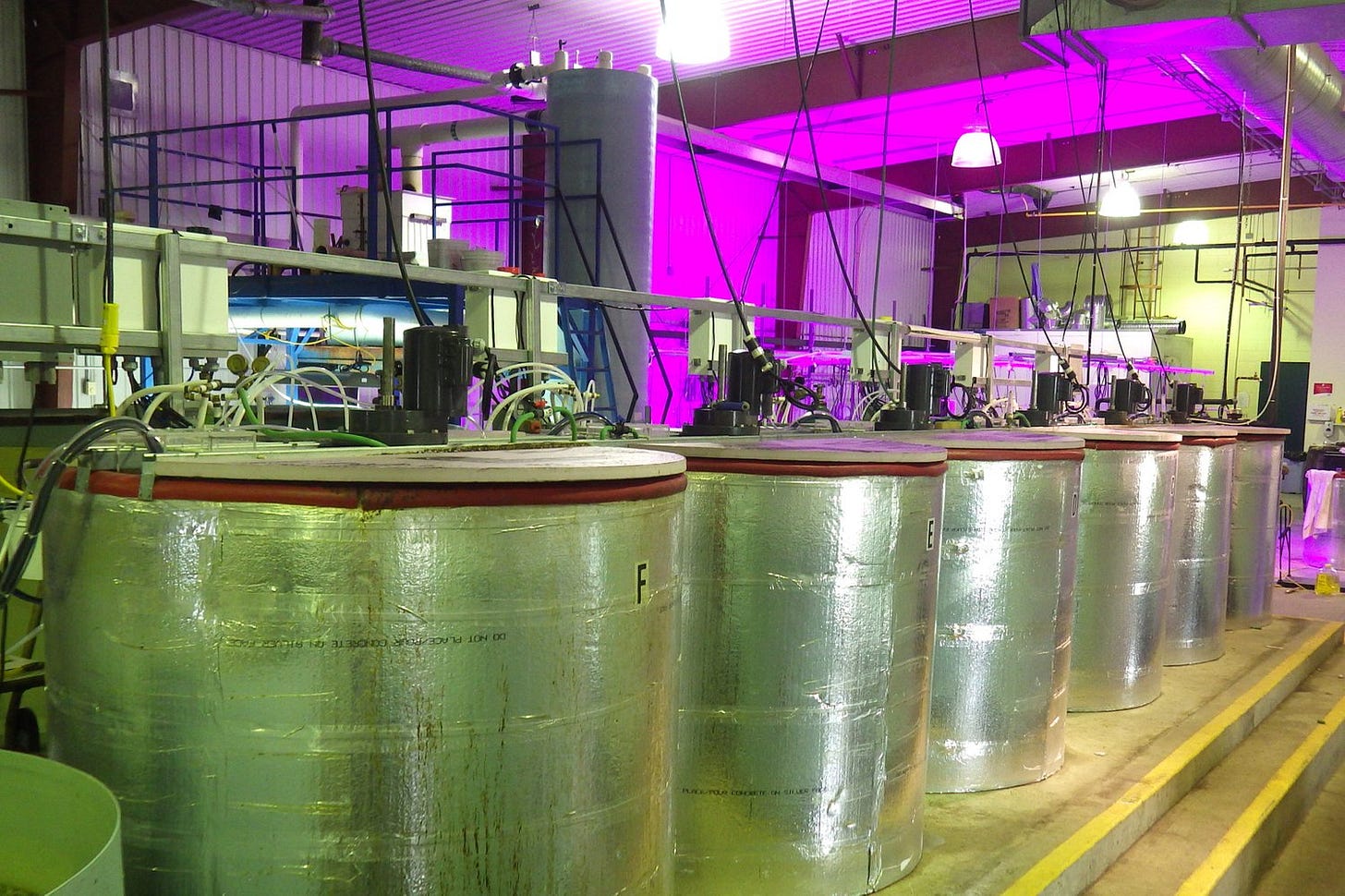CEA, Vertical, and Indoor Farms Have the Vision, but Do They Have the Energy? Part I
Innovative farms are crucial to feeding the sprawl of densely populated urban demographics. But these innovative farms all have one thing in common, they use a massive amount of electricity.
I have said it before and I will say it again. Controlled-environment agriculture (CEA) is an industry that will usher in a new Green Agricultural Revolution and dramatically shift the way humans grow food. It is set to continue to skyrocket in the coming years and well into the future. In 2021, the global indoor-farming industry was valued at $79.3 billion, with the potential to climb to $155.6 billion by 2026, per Pitchbook.
Green Rush/Revolution
We are currently in the third green revolution and must power through to sustain the growth of our cities. No longer are we able to rely on the countryside for food, people all over the world are moving to cities. This type of production will take the natural and unpredictable processes of conventional agriculture farming and transition them to a process as tightly run as a “Plant Factory” that fits into the skyscraper developments of the world and cultural tech hubs.

Despite its growth and future prospect, there are structural and utility challenges the industry needs to address and overcome before CEA can hold a candle to conventional agricultural operations Challenges include hiring an adequate number of technical experts, securing the capital to build out massive infrastructure like the cold storage, warehousing, and greenhouses, all while paying to install and operate the expensive slate of technologies that give you data on your yields, temperatures, PAR values, pH, automation hardware and software, not including the hundreds of sensors, and tens of thousands of LED lights needed to maintain and monitor the system as a whole.
Reality
CEA engineer & advisor Erika Summers details in an April 2023 interview why (vertical) farming isn’t a ‘get-rich-quick’ industry. “In this industry we hear a lot about LED lights and AI controls, but you get fewer people talking about the mechanical equipment side of controlled environment agriculture (CEA) because it is simply more challenging,”
Summers (ES), who runs her own CEA advisory firm, is also a mechanical engineer who has worked with many indoor farming clients on HVAC systems and other building considerations. AFN recently sat down with her to discuss the mechanical side of vertical farming, what her dreams for CEA are, and why you can’t, in fact, build a vertical farm anywhere, despite what the Yes Men might say. Those Yes Men avoid the conversations of the maintenance, utility, and ongoing costs and tend to over-embellish the reality of the system. This has caused more than a fair share of systems and companies to close their doors and cease to exist.
One of the biggest changes that need to happen in CEA farming is the nature of its operations as well as its energy requirements and source. Summers says “Farming isn’t a get-rich-quick thing. It requires hard work and takes time to pay off. All of these companies that announce crazy amounts of money raised and claim to be opening their doors in six months break my heart. You can’t build an efficient farm that fast. When I see claims like that you just know the build-out is going to be rushed, the equipment selected is going to be off the shelf because that is what’s available, and I question if enough thought has gone into making a viable long-standing business.”
This addresses one problem but the reality of CEA is the energy use. Summers addresses her concerns with energy and indoor production, “Some people talk about equipping farms with solar. I would love to see solar applied in this industry, but to make solar effective you need storage batteries to provide a consistent supply. Without that, you still need to have the infrastructure in place to power the facility if it is a cloudy day. That technology is definitely getting there, but it’s not applied in this industry yet because it’s expensive.

Taking measures to use energy-efficient equipment like chillers and LED does help, but it is still a lot.
We should be looking to do things like co-locating vertical farms in locations that have cheaper power like hydro electrics. Another option is to really work with the power companies as a team to bring down operation costs. That might mean running equipment at off-peak times, which helps.” Read her whole interview with Jennifer Martson on Ag Funder News here.
Energy consumption is the biggest challenge these farms face. Unlike conventional outdoor agricultural growing, which relies on the solar radiation, light, and true power of the sun, indoor farms are dependent on supplemental LED lighting to reach their ideal radiation and PAR values. Energy costs can run tremendously high, threatening profitability during peak usage times, and using fossil-fuel-powered electricity can increase the carbon footprint that the system was potentially going to divert. These issues erase the environmental benefits of indoor farming. This is especially true for vertical farms in particular.
“A lot of these light companies are really making good strides with efficiency and driving down costs, which is a big component, probably the biggest component, of these companies becoming profitable,” Alex L. Frederick, senior emerging technology and venture capital analyst at Pitchbook, told Emerging Tech Brew.
By understanding that energy is the biggest hurdle that these farms face you can identify the problem and work towards a solution. Producing kWh on site.

Getting The Lights On
Indoor farming is dependent almost exclusively on energy-intensive systems like LED lighting, HVAC air-conditioning systems to circulate and control the temperature and relative humidity, water-filtration systems to circulate and purify the water used to hydrate or mist plants, bio-reactor systems to produce macro and micronutrients in a controlled manner, massive pump systems that have enormous energy demands all day, and, in some cases of aquaponics systems, a closed-loop system of fish habitation and waste management digestor and system to gather nutrients from fish and turn them into fertilizer for plants which require temperature and air controls.
No wonder power prices keep going up. Well, at least these systems save water. According to the 2021 Global CEA Census Report, CEA farms can use up to 90%–95% less water than traditional farms, by emphasizing water conservation and reuse. About two-thirds (66%) of the indoor farms surveyed reached this threshold.
But with those water savings comes a cost. The report found that vertical farms have a significantly higher average energy use at 38.8 kWh per kg of produce compared to traditional greenhouses, which average 5.4 kWh per kg. That is over six times more energy usage than conventional agriculture.

In the 2019 CEA Census, 41% of CEA firms in the US surveyed said they don't currently track data related to energy use. And, overall, 64% of respondents worldwide stated they don’t implement any “energy-efficiency strategies to minimize their energy consumption,” despite energy being the highest cost in indoor farming aside from labor. Now the idea of these farms is to be more carbon friendly and relying on renewable energy is “ideal,” but it can still be a challenge. Given the intermittent availability of sources like solar and the industry’s need for 24/7 electricity, it may not work in most cases. So what can farms do to decrease their dependence on electricity from the US utility market? Bio-digestors, PV, and passive electricity systems.
Anaerobic and Aerobic Bioreactors
Please stay tuned for a dive into Methane digesters and other passive systems that can produce energy for a localized CEA system







This is informative, but the problems presented to do not seem to dampen your enthusiasm for the plan. If you were to assess the myriad of chemical pollutants churned out in the manufacturing of all these various components (and including vaunted anaerobic bioreactors), you would quickly surmise that these systems create vastly more environmental pollution than plants in dirt. Whether or not economically profitable, they are a faux solution to environmentally-improved food production.....